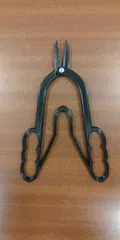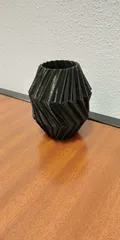Pendulum Clock Mechanism
Description
PDFI made this clock more has a proof of concept, its not meant to be a smooth mechanism or a pretty one.
I tried to minimize the number of 3d printed parts as much as I could (only the gears, gear stand, clock hands and pendulum holder), so the box, clock face, pendulum, cords and weights are all objects I used as temporary substitutes. The joinery in the stand for the clockwork might be a little too brittle, hence the rubber bands holding it in place.
I used rectangle wooden skewers as axles for the gears, but those proved to create much friction. I recommend using plastic or metal axles for a smoother running mechanism (this will probably require changing the holes for the axles in the Scad files below). I also recommend a longer pendulum than the one in the pictures, the duration of a second in this sort of mechanism is decided by the length of the pendulum according to the following formula:
T = 2π . square_root(g/L)
where:
T is the period of the pendulum (time for one complete oscillation),
π is pi, a mathematical constant (approximately 3.14159),
L is the length of the pendulum
g is the acceleration due to gravity
All the Scad code is in this page and is easy to modify. How the many pieces fit together should be intuitive and easy to understand from the photos, except the cord for the weights. The cord should be coiled and lightly tied around the cordwheel (made from connecting the cordwheel cap and cordwheel click with 2 bars/rods) like in the example, and should not interfere with the spinning motion of the gear axle going through the center of the cordwheel. The cord should be tied to 2 weights, one on each end, with a heavier weight on the right side of the mechanism, it should be the minimum weight necessary to move the gears smoothly.
Since this has the pendulum and weights underneath the base of the gear stand, this mechanism needs to be hanged on a wall for it to work, unless you modify the stand to be taller.
Tags
Model origin
The author marked this model as their own original creation.



